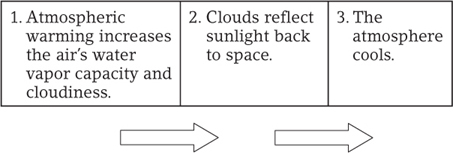3.6 Clouds and Climate

Assess the interaction between cloud feedbacks and climate.
How will Earth’s climate change during our lifetimes? This is the question climatologists—scientists who study climate—
According to the IPCC (Intergovernmental Panel on Climate Change), computer modeling studies indicate that the global temperature may rise anywhere between 2°C and 6°C (3.6°F to 10.8°F) by 2100 (see Section 6.4). These estimates represent a large range of uncertainty. Although many factors will be important in determining how much the temperature increases, the leading factors behind this uncertainty are how much CO2 will be emitted to the atmosphere by human activity and how clouds will respond to atmospheric warming.
Clouds and Temperature
We learned in this chapter that as air temperature increases, evaporation is enhanced. Enhanced evaporation will put more water vapor into the atmosphere, and the atmosphere could become cloudier as a result. Whether or not a warmer world will be a cloudier world is uncertain, however. Higher temperatures do not always make more clouds. Both atmospheric water vapor and unstable air are necessary for cloud formation. Summer is not necessarily cloudier than winter, even though it is warmer and the specific humidity is often higher.
Temperature can change cloudiness, and cloudiness can change temperature. Clouds cool Earth’s surface and atmosphere as their high-

Clouds also warm the atmosphere by absorbing longwave energy emitted from Earth’s surface. This terrestrial heat is delayed on its way back to space because it is absorbed by clouds (and by greenhouse gases) in the atmosphere, then radiated back to Earth’s surface. Scientists call this effect cloud greenhouse forcing (Figure 3.35). Cloud greenhouse forcing causes warming, or positive forcing.

All clouds cause both negative forcing (cooling) and positive forcing (warming) simultaneously. How, then, would a changing climate influence cloud forcing? Scientists have not yet found the answer, but it lies somewhere in cloud feedbacks.
Cloud Feedbacks
Whether clouds will accelerate the current warming trend or slow it down depends on whether they produce stabilizing or destabilizing feedbacks. Feedbacks are changes that cause other changes, or a cause-

negative feedback
A process in which interacting parts in a system stabilize the system.
positive feedback
A process in which interacting parts in a system destabilize the system.
Cloud negative feedbacks keep the temperature stable. Cloud positive feedbacks change the temperature. In the example given below, a cloud positive feedback causes a warming trend:

Stratus Clouds
There are potentially dozens of cloud feedbacks. For example, clouds form multiple layers, ranging from low-
Stratus clouds usually either produce negative forcing (cooling) or are neutral. Where they produce negative forcing, their absence can allow the Sun to heat the ground more intensely, thereby warming the air above the ground as heat is radiated off Earth’s surface. In some geographic regions, stratus clouds may decrease as the temperature in the lower atmosphere increases, leading to this feedback:

Cirrus Clouds
Higher up, cirrus clouds are mostly transparent to shortwave solar energy and allow it to pass through to Earth’s surface. However, they absorb longwave radiation from Earth’s surface efficiently. Some research indicates that high-

In contrast, other studies suggest that there will be fewer cirrus clouds within the tropics as the atmosphere warms. Therefore, the tropics could experience negative forcing (cooling) from cirrus clouds:

Currently, taken as a whole, cloud feedbacks are causing net cooling worldwide. Some scientists think that cloud negative feedbacks could significantly slow anthropogenic atmospheric warming and buy time to reduce our carbon emissions (see Section 6.4). The scientific consensus, however, is that while negative cloud feedbacks could slow anthropogenic climate change, they will not stop it. Other factors could accelerate atmospheric warming trends and lead to a destabilizing positive feedback. Given all these different possible outcomes, understanding how clouds and their feedbacks will respond to climate change is among the highest priorities and greatest challenges for climatologists.